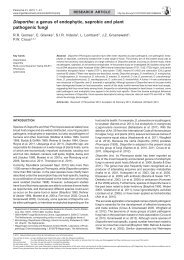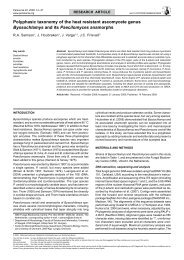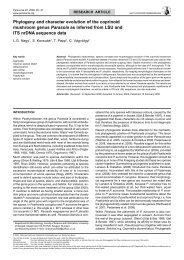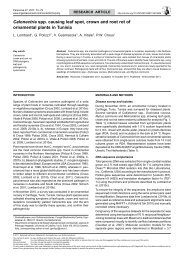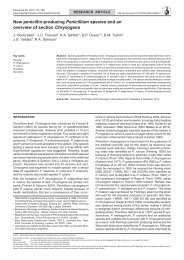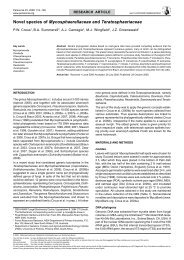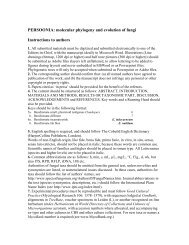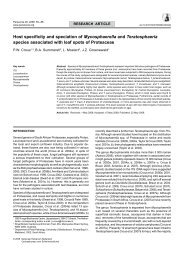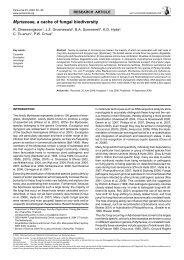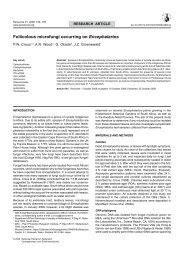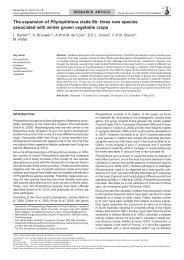Phylogeny and taxonomy of obscure genera of microfungi - Persoonia
Phylogeny and taxonomy of obscure genera of microfungi - Persoonia
Phylogeny and taxonomy of obscure genera of microfungi - Persoonia
Create successful ePaper yourself
Turn your PDF publications into a flip-book with our unique Google optimized e-Paper software.
P.W. Crous et al.: Obscure <strong>genera</strong> <strong>of</strong> micr<strong>of</strong>ungi<br />
151<br />
dles (colonies also sporulate well on OA <strong>and</strong> MEA): Mycelium<br />
predominantly internal in host tissue, consisting <strong>of</strong> branched,<br />
septate, smooth, brown, 2–2.5 µm wide hyphae. Conidiomata<br />
sporodochial, scattered, black, up to 170 µm diam. Conidiophores<br />
subcylindrical, darker brown than hyphae, at times<br />
slightly verruculose, irregularly curved to geniculate-sinuous,<br />
1–3-septate, 10–25 × 2–2.5 µm; older conidiophores curved<br />
like sheperd’s crook. Conidiogenous cells terminal, medium<br />
brown, verruculose, subcylindrical, curved (semi-circular), 5–10<br />
× 2–2.5 µm. Conidia solitary, complanante, cheiroid, smoothwalled,<br />
uniformly pale brown, becoming uniformly medium<br />
brown at maturity; cells arranged in (4–)5(–6) rows, meeting at<br />
basal cell; outer rows with 8–10 cells, with a hyaline, globose,<br />
apical appendage, 5–10 µm diam; outer rows shorter than inner<br />
rows; inner rows with 7–11 cells; central row with 6–10 cells;<br />
conidia (30–)40–46(–55) × (20–)21–23(–25) µm.<br />
Characteristics in culture — Colonies on OA flat, spreading,<br />
without aerial mycelium, <strong>and</strong> with regular, even margin; on MEA<br />
flat, spreading, with moderate aerial mycelium <strong>and</strong> regular,<br />
smooth margin; surface buff, reverse cinnamon; colonies on<br />
both media reaching 30 mm diam after 1 mo at 25 °C.<br />
Specimen examined. South Africa, KwaZulu-Natal, Skyline Nature<br />
Reserve, Uvongo, on dead leaves <strong>of</strong> Strelitzia nicolai, 29 May 2008, leg.<br />
A. Wood, isol. P.W. Crous, CBS H-20202 holotype, cultures ex-type CPC<br />
15359–15361, CBS 123359.<br />
Notes — The genus Dictyosporium is well defined, <strong>and</strong> separated<br />
from similar <strong>genera</strong> by having smooth-walled, euseptate<br />
conidia produced from determinate conidiogenous cells (Sutton<br />
et al. 1996, Tsui et al. 2006). Based on the key provided by Cai<br />
et al. (2003b), D. strelitziae is morphologically most similar to<br />
D. bulbosum (conidia 27–46 × 11–30 µm), but its conidia are<br />
somewhat longer, <strong>and</strong> there is a 10 bp difference between the<br />
ITS sequences <strong>of</strong> D. strelitziae <strong>and</strong> D. bulbosum (DQ018086).<br />
Phylogenetically, D. strelitziae is closest to D. elegans (conidia<br />
44–80 × 24–36 µm; appendages absent) (5 bp difference in<br />
the ITS sequence, DQ018087), but it has smaller conidia than<br />
the latter species. Furthermore, it also appears distinct from all<br />
species not occurring in the key <strong>of</strong> Cai et al. (2003b) (Arambarri<br />
et al. 2001, Cai et al. 2003a, Zhao & Zhang 2003, Kodsueb et<br />
al. 2006, Cai & Hyde 2007, McKenzie 2008).<br />
Key to species <strong>of</strong> Dictyosporium<br />
(adapted from Cai et al. 2003b)<br />
1. Conidia with appendages. . . . . . . . . . . . . . . . . . . . . . . . . 2<br />
1. Conidia lacking appendages . . . . . . . . . . . . . . . . . . . . . 13<br />
2. Appendages apical . . . . . . . . . . . . . . . . . . . . . . . . . . . . . 3<br />
2. Appendages not apical . . . . . . . . . . . . . . . . . . . . . . . . . . 4<br />
3. Apical appendages aseptate . . . . . . . . . . . . . . . . . . . . . . 6<br />
3. Apical appendages frequently 1-septate, cylindrical, 24–51<br />
× 6–10.5 µm; conidia 27.5–47.5 × 20–25 µm, complanate,<br />
with 4–5 rows <strong>of</strong> cells . . . . . . . . . . . . . . . . D. canisporum<br />
4. Appendages subapical, cylindrical to clavate; conidia 52.5–<br />
72.5 × 18.5–26.5 µm, not complanate, with 5 rows <strong>of</strong> cells<br />
. . . . . . . . . . . . . . . . . . . . . . . . . . . . . . . . . . D. tetraploides<br />
4. Appendages not subapical, but central or basal . . . . . . . 5<br />
5. Appendages central, hyaline, thin-walled, clavate to obovoid;<br />
conidia 36–45 × 16–21 µm, not complanate, mostly 7 rows<br />
<strong>of</strong> cells . . . . . . . . . . . . . . . . . . . . . . . . . . . . . . . . D. musae<br />
5. Appendages basal, fusoid to cylindrical; conidia 22–28 × 12.5–<br />
18 µm, complanate, with 3 rows <strong>of</strong> cells . . D. manglietiae<br />
6. Conidia with 3 rows <strong>of</strong> cells, (27–)31–43 × 10–12 µm . . .<br />
. . . . . . . . . . . . . . . . . . . . . . . . . . . . . . . . . . D. freycinetiae<br />
6. Conidia with more than 3 rows <strong>of</strong> cells . . . . . . . . . . . . . . 7<br />
7. Conidia mostly with 4 rows <strong>of</strong> cells . . . . . . . . . . . . . . . . . 8<br />
7. Conidia with 5 or more rows <strong>of</strong> cells . . . . . . . . . . . . . . . 10<br />
8. Conidia with darker colour at apex <strong>of</strong> inner rows; apical<br />
cells <strong>of</strong> outer rows each bearing a hyaline, cylindrical appendage.<br />
. . . . . . . . . . . . . . . . . . . . . . . . . . D. nigroapice<br />
8. Conidia concolorous . . . . . . . . . . . . . . . . . . . . . . . . . . . 9<br />
9. Conidia 24–40 × 14–20 µm; appendages clavate . . . . .<br />
. . . . . . . . . . . . . . . . . . . . . . . . . . . . . . . . . . D. tetraseriale<br />
9. Conidia 36–45 × 16–21 µm; appendages tapering . . . .<br />
. . . . . . . . . . . . . . . . . . . . . . . . . . . . . . . . . . . . . D. palmae<br />
10. Conidia mostly comprising 5 rows <strong>of</strong> cells. . . . . . . . . . 11<br />
10. Conidia mostly comprising 6–8 rows, 46–88 × 26–46 µm;<br />
appendages hyaline, curved . . . . . . . . . . . . D. digitatum<br />
11. Conidia longer than 32 µm, appendages globose to obovoid<br />
. . . . . . . . . . . . . . . . . . . . . . . . . . . . . . . . . . . . . . 12<br />
11. Conidia shorter than above, 26–32 × 15–24 µm; appendages<br />
cylindrical to clavate . . . . . . . . . . . . . . . . D. alatum<br />
12. Conidia up to 46 µm long, <strong>and</strong> 30 µm wide, 27–46 × 11–30<br />
µm; appendages globose to obovoid . . . . . D. bulbosum<br />
12. Conidia longer than 46 µm, but not wider than 25 µm,<br />
(30–)40–46(–55) × (20–)21–23(–25) µm; appendages<br />
globose . . . . . . . . . . . . . . . . . . . . . . . . . . . . D. strelitziae<br />
13. Conidia complanate, one cell layer thick . . . . . . . . . . . 14<br />
13. Conidia not complanate, more than one cell layer thick 24<br />
14. Conidia regularly consisting <strong>of</strong> 3 rows <strong>of</strong> cells. . . . . . . 15<br />
14. Conidia consisting <strong>of</strong> at least 4 rows <strong>of</strong> cells . . . . . . . . 16<br />
15. Conidia 15–22.5 × 10–16.5 µm . . . . D. lakefuxianensis<br />
15. Conidia 26–32 × 16–18 µm . . . . . . . . . . . . . D. triseriale<br />
16. Conidia curved, with 5–7 rows <strong>of</strong> cells, each curving in the<br />
same direction, 34–56 × 20–38 µm . . . . . . . . D. foliicola<br />
16. Conidia not curved . . . . . . . . . . . . . . . . . . . . . . . . . . . 17<br />
17. Conidia less than 25 µm long . . . . . . . . . . . . . . . . . . . 18<br />
17. Conidia more than 25 µm long . . . . . . . . . . . . . . . . . . 19<br />
18. Conidia 18–24 × 13–19 µm . . . . . . D. brahmaswaroopii<br />
18. Conidia 15–17 × 11–12 µm . . . . . . D. schizostachyfolium<br />
19. Conidia with paler outer rows . . . . . . . . . . . . . . . . . . . 20<br />
19. Conidia concolorous . . . . . . . . . . . . . . . . . . . . . . . . . . 21<br />
20. Conidia 25–45 × 22–38 µm, with (5–)6(–7) rows . . . . .<br />
. . . . . . . . . . . . . . . . . . . . . . . . . . . . . . . . D. yunnanensis 1<br />
20. Conidia 26–40 × 13–25 µm, mostly with 5 rows. . . . . . .<br />
. . . . . . . . . . . . . . . . . . . . . . . . . . . . . . . . . . D. zeylanicum<br />
21. Conidia with 4 rows, 23.5–40 × 16–21.5 µm . . . . . . . . .<br />
. . . . . . . . . . . . . . . . . . . . . . . . . . . . . . . . . D. tetrasporum<br />
21. Conidia with more than 4 rows . . . . . . . . . . . . . . . . . . 22<br />
22. Conidia 40–80 × 24–36 µm, mostly with 5 rows, slightly<br />
constricted at septa . . . . . . . . . . . . . . . . . . . . D. elegans<br />
22. Conidia mostly with more than 5 rows, strongly constricted<br />
at septa . . . . . . . . . . . . . . . . . . . . . . . . . . . . . . . . . . . . 23<br />
23. Conidia 26–34 × 23–34 µm, mostly with 7–9 rows <strong>of</strong> cells;<br />
conidiomata sporodochial . . . . . . . . . . . . D. polystichum<br />
23. Conidia 38–56 × 25–32 µm, mostly 6–8 rows <strong>of</strong> cells;<br />
conidiomata not sporodochial . . . . . . . . . . . D. toruloides<br />
24. Conidia campaniform, with a darker base; with 12–16 rows<br />
<strong>of</strong> cells, 22–40 × 20–30 µm . . . . . . . . D. campaniforme<br />
24. Conidia more or less cylindrical, concolorous, comprising<br />
3–7 rows <strong>of</strong> cells . . . . . . . . . . . . . . . . . . . . . . . . . . . . . 25<br />
25. Conidia regularly with 3 rows <strong>of</strong> cells; usually 13.5 µm or<br />
less wide . . . . . . . . . . . . . . . . . . . . . . . . . . . . . . . . . . . 26<br />
25. Conidia mostly with 4–7 rows <strong>of</strong> cells; more than 13.5 µm<br />
wide . . . . . . . . . . . . . . . . . . . . . . . . . . . . . . . . . . . . . . . 28<br />
1<br />
Appearing morphologically similar to D. taishanensis, also described<br />
from China; conidia with (3–)5(–7) cell layers, 27–43 × 15–30 µm (Zhao<br />
& Zhang 2003). Dictyosporium taishanensis (22 February 2003) is older<br />
than D. yunnanensis (March 2003), <strong>and</strong> would have priority if these fungi<br />
are shown to be synonymous.



